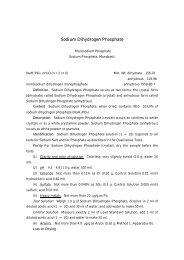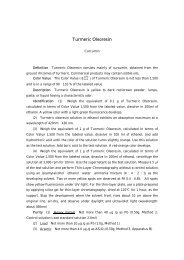Flavoring Substances Tests
Flavoring Substances Tests
Flavoring Substances Tests
You also want an ePaper? Increase the reach of your titles
YUMPU automatically turns print PDFs into web optimized ePapers that Google loves.
B. GENERAL TESTS<strong>Flavoring</strong> <strong>Substances</strong> <strong>Tests</strong>1. Alcohol Content The alcohol content is the quantity of alcohols contained in a sample. Procedure Unless otherwise specified, proceed as directed in Method 1 orMethod 2, as appropriate. Method 1 Measure exactly 10 ml of the sample, transfer into a 100-ml flask,and add 10 ml of acetic anhydride and 1 g of anhydrous sodium acetate. Connect theflask to an air condenser, and boil the mixture gently on a hot-plate for 1 hour. Allowto cool for 15 minutes, and add 50 ml of water. Heat the mixture in a water bath for15 minutes while shaking occasionally. Cool, transfer the mixture into a separatingfunnel, and remove the aqueous layer. Wash the oil layer with anhydrous sodiumcarbonate solution (1 8) until the washings become alkaline, wash further withsodium chloride solution (1 10) until the washings become neutral. Transfer theoil layer into a dry container, add about 2 g of anhydrous sodium sulfate, shake well,allow to stand for about 30 minutes, and filter. Weigh accurately the specifiedquantity of the acetylated oil thus obtained, and determine the ester value as directedunder Ester Value in the <strong>Flavoring</strong> <strong>Substances</strong> <strong>Tests</strong>. This ester value, also referredto as acetyl value, is calculated by the formulaAcetyl value =(ab)28.05Weight(g) of acetylated oilCalculate the alcohol content by the formula Alcohol contentMolecular weight of alcohol(ab)0.5= 100(%),Weight (g) of acetylated oil0.02102(ab)1,000Acetyl valueMolecular weight of alcohol= (%),561.1(0.4204Acetyl value)where a = volume (ml) of 0.5 mol/l hydrochloric acid consumed in the blanktest,
B. GENERAL TESTSwhere a = volume (ml) of 0.5 mol/l hydrochloric acid consumed in the blank test,b = volume (ml) of 0.5 mol/l hydrochloric acid consumed in the test.4. Ester ContentThe content of ester of monobasic acid is obtained by performing the test asdirected under Ester Value in <strong>Flavoring</strong> <strong>Substances</strong> <strong>Tests</strong> and then calculating by theformulaMolecular weight of ester(ab)0.5Ester content = 100 (%) ,Weight (g) of the sample1,000Ester valueMolecular weight of ester= (%),561.1where a and b are the a and the b, respectively, indicated in Ester Value.5. Halogenated CompoundsHalogenated Compounds are identified by utilizing the flame coloration of copperchloride.Procedure Use a copper gauze of 1.5 cm in width, 5 cm in length, and about 1mm in mesh, which is wound around the end of a copper wire. Heat the copper gauzein a colorless flame of the burner until no green color is observed in the flame, cool,and repeat this procedure several times. After cooling, moisten the copper gauze with2 drops of the sample, and burn. Repeat this procedure three times, and burn thegauze in the outer edge of a colorless flame adjusted to the height of about 4 cm. Nogreen color develops in the flame.6. Saponification ValueThe saponification value is the number of mg of potassium hydroxide (KOH)required to saponify the ester and neutralize the free acid contained in 1 g of asample.Procedure Unless otherwise specified, proceed as follows: Weigh accurately thespecified quantity of a sample, and transfer into a 200-ml flask. Add 25 ml of 0.5mol/l ethanolic potassium hydroxide, exactly measured, equip the flask with a refluxcondenser, and gently boil in a water bath for 1 hour. Cool, and titrate the excessalkali with 0.5 mol/l hydrochloride acid. Confirm the end point using a indicator (1mlof phenolphthalein TS) or a potentiometer. Perform a blank test in the same manner,and calculate the saponification value by the formulaSaponification value =(ab)28.05Weight (g) of the sample
B. GENERAL TESTSwhere a = volume (ml) of 0.5 mol/l hydrochloric acid consumed in the blank test,b = volume (ml) of 0.5 mol/l hydrochloric acid consumed in the test.7. Acid ValueThe acid value is the number of mg of potassium hydroxide (KOH) required toneutralize 1 g of a sample.Hereinafter in the Monographs, such a specification asnot more than 6.0(<strong>Flavoring</strong> <strong>Substances</strong> <strong>Tests</strong>)indicates that when determined as directed in thefollowing procedure, the acid value is not more than 6.0.Procedure Unless otherwise specified, proceed as follows: To about 10 g of asample, accurately weighed, add about 50 ml of neutralized ethanol, dissolve bywarming if necessary, and add several drops of phenolphthalein TS. Titrate whileshaking occasionally with 0.1 mol/l potassium hydroxide, using a microburet until alight pink color persists for 30 seconds, or a potentionmetr. Calculate the acid valueby the following formulaVolume (ml) of 0.1 mol/l potassium hydroxide consumed5.611Acid value =Weight (g) of the sample8. Phenol ContentThe phenol content is the quantity of alkali hydroxide-soluble substancescontained in a sample.Procedure Unless otherwise specified, proceed as follows: Transfer 10 ml of asample, exactly measured, into a 150-ml cassia flask, and add 75 ml of 1 mol/lpotassium hydroxide divided into 3 portions while shaking well. Shake well for 5minutes, allow to stand for 30 minutes, and gradually add 1 mol/l potassiumhydroxide to raise the insoluble oil layer to the graduated part of the cassia flask.Allow to stand for 1 hour, read the volume of the insoluble oil (ml), and calculate thecontent by the formulaPhenol content = 1010Volume (ml) of insoluble oil(% vol).
















